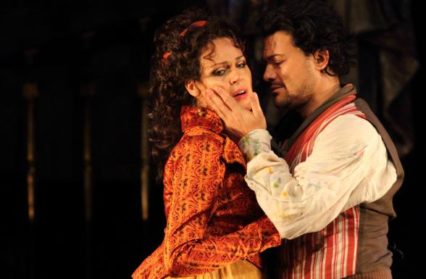David Truslove travelled to Covent Garden to witness Tosca, the latest production from the Royal Opera House featuring Bryn Terfel, Kristine Opolais and Vittorio Grigòlo.
This Royal Opera House production first saw the light of day in 2006 under Jonathan Kent, and now, under Andrew Sinclair, Tosca is enjoying its umpteenth revival. It’s a no-frills, traditional presentation, endowed with the late Paul Brown’s period costumes and handsome, if somewhat heavy, designs. They traverse the candlelit clutter of the Sant’Andrea della Valle (with its profusion of railings surrounding the altar), Scarpia’s opulent book-lined apartment in the Palazzo Farnese (grim realities of a torture chamber hidden from view) through to a minimalist rooftop outline (parapet and little else) with a picture-book night sky.
The opening gloom of Act One, with its increasing shadows and silhouettes (courtesy of Mark Henderson’s atmospheric lighting) conveys both foreboding and oppression, and neatly underlines the impending tragedy. There’s a magnificent fresco of Mary Magdalen and an imposing eagle perched above the Castel Sant’Angelo, both visually arresting yet not overburdened with colour or detail.
As one of the most performed operas in the repertoire, Tosca is a box office banker, its revivals rewarding our continuing fascination with its passionate tale of love, murder and suicide, and deepening too our appreciation of its fabulous music. So, if we’re already familiar with plot and music; what does a revival provide that we haven’t already experienced? Perhaps it’s like returning to the face of a much-loved friend – age and experience re-focus our perspectives, attitudes mellow or sharpen, and musical/theatrical details of orchestration, phrasing or the clamour of bells (that I’d forgotten in Act Three) may arrive with renewed clarity. Features once partially heard or seen are now vividly brought to life. Clearly there’s still an appetite for Tosca and this production replaced the legendary affair by Franco Zeffirelli which returned time and again over four decades to achieve an impressive 242 performances.
In this current run, singing and characterisation are generally persuasive. Latvian soprano Kristine Opolais makes a creditable Floria Tosca, impressing as an insecure and coquettish lover in Act One, vulnerable yet courageous in Act Two, with a ‘Vissi d’arte’ demonstrating great control and just enough humanity to secure rapturous applause. She can be melodramatic too, and her response to Cavaradossi’s murder pushes the decibels into new heights.
What’s missing is any believable chemistry between her and newcomer Vittorio Grigòlo making his first Cavaradossi at Covent Garden. He’s absolutely assured in this role and slicking back his hair with holy water in Act One makes for a nice distinctive touch. With little opportunity to warm up he sails through ‘Recondita armonia’ (sitting atop some precarious-looking scaffolding) with a no-holds-bared voice that startles from the off. It’s a remarkable performance, his ringing tones dazzling in the brief victory celebrations of Act Two – a passionate outburst that’s an emotional high point.
Bryn Terfel holds the eye as Scarpia with a subtle mixture of suavity and menace to create an understated villainy – but I wonder if he might inject some coarseness into a voice that would remove some of the varnish. It’s a handsome tone, arguably too warm for the malevolence the role requires. That said we are in no doubt of his designs on Tosca expressed through insinuation and tiny caresses which bring a palpable tension, something clearly missing from the relationship between Grigòlo and Opolais.
Other characters are well-drawn – Jonathan Lemalu in fine form as a strikingly resonant Sacristan, Michael Mofidian as the luckless fugitive Angelotti, Hubert Francis a disturbing Spoletta and Joshua Abrams ear-catching as the Shepherd-boy. The Royal Opera Chorus and pupils from Cardinal Vaughan Memorial School provide splendidly robust singing and in the pit Alexander Joel provides idiomatic direction. If the opening chords don’t hurl you back in your seat with their shock value, there’s much to enjoy elsewhere with some vigorous tempi and much clarity of orchestral detail – including a sumptuous beginning to Act Three. All in all, it’s a good show, yet if productions such as these are not to become museum pieces then the quality of singing and acting needs to engage with equal conviction. Perhaps in time this Tosca will leave a more memorable impression as relationships are refined and find deeper resonances.
Puccini’s Tosca [Sung in Italian with English surtitles]
Director – Jonathan Kent
Revival Director – Andrew Sinclair
Designer – Paul Brown
Lighting – Mark Henderson
Tosca – Kristine Opolais
Cavaradossi – Vittorio Grigòlo
Scarpia – Bryn Terfel
Angelotti – Michael Mofidian
Sacristan – Jonathan Lemalu
Spoletta – Hubert Francis
Sciarrone – Jihoon Kim
Gaoler – John Morrissey
Shepherd Boy – Joshua Abrams
Chorus and Orchestra of the Royal Opera House
Conductor – Alexander Joel
Header Image – Kristine Opolais as Tosca and Vittorio Grigòlo as Cavaradossi – Credit: Catherine Ashmore











